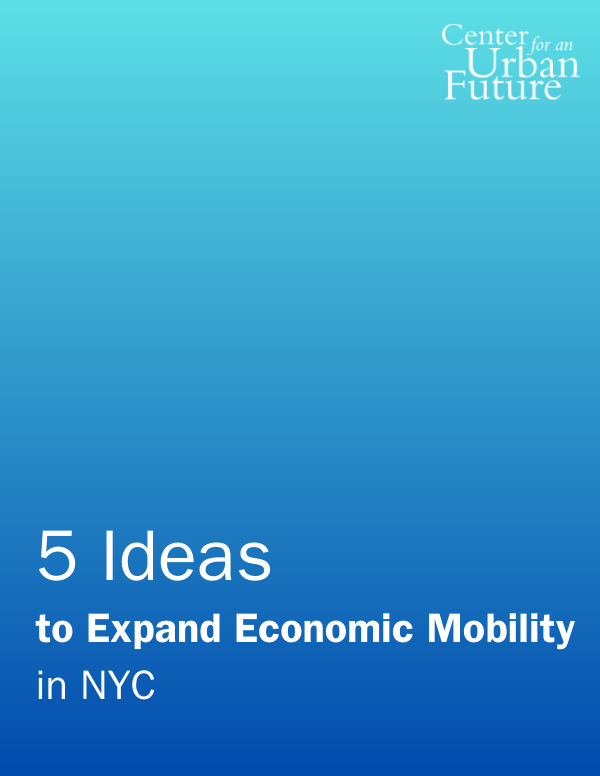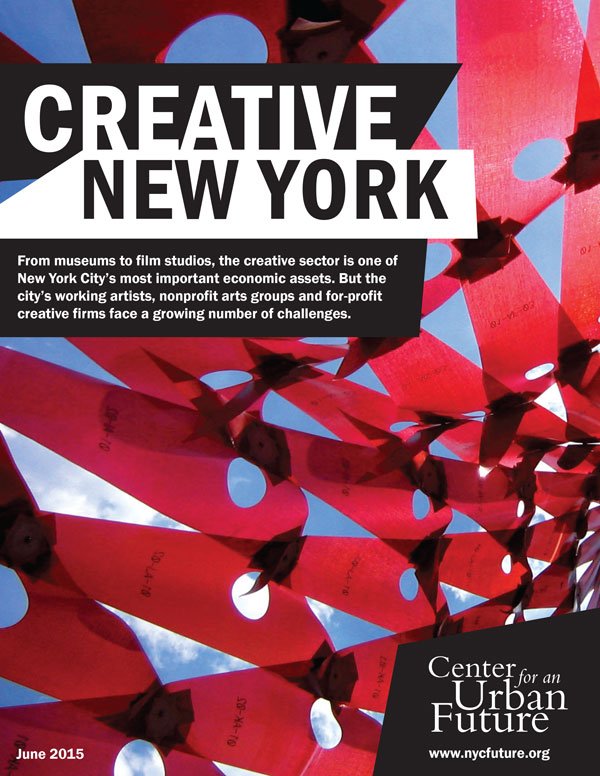On Wednesday, October 16th, the Center for an Urban Future convened a policy symposium as part of our Middle Class Jobs Project which asked the question, “Are creative industries the future of middle class jobs in NYC?” The answer from our expert panelists was a resounding yes, and the data backs them up.
Creative industries like advertising, film, architecture, and design now employ more than 300,000 people in New York City, including tens of thousands in positions that pay middle-income wages. Perhaps even more important, these fields are producing a growing share of the new well-paying jobs being created across the five boroughs.
Indeed, while New York City has seen record job growth in recent years, adding over 800,000 jobs since the recession, far too many of those jobs have been low-wage positions with little room for advancement. And the segments of the city’s economy which have traditionally been seen as anchors of the middle class, such as hospitals, finance, and legal services, have seen marginal growth, if any, during the past fifteen years. Manufacturing in particular has lost well over 50,000 jobs in that period.
But one area where higher wage jobs are being created in large numbers is the creative industries. In the past fifteen years, the city has added 27,000 jobs in advertising, 19,000 jobs in film and television, 14,000 jobs in the performing arts, and 6,000 jobs in architecture. New York is well positioned for even more growth in the creative sector, thanks to the city’s outsized market share in advertising, publishing, film/tv, and fashion, to name just a few. And compared to fields like accounting and business services, the creative sector is remarkably insulated from automation.
Yet sustaining this growth, and maintaining New York’s position as an international beacon of the creative economy, will likely require significant effort on the part of city policymakers, industry leaders, and others.
Creative industries have not been an integral part of discussions about middle-class jobs in New York, but as our policy discussion made clear, this almost certainly needs to change. On the one hand, maintaining New York’s position as an international beacon of the creative economy will need to become a priority for economic development officials. At the same time, New York City policymakers and industry leaders will need to take steps to ensure that more low-income New Yorkers have access to the well-paying jobs in the sector.
The following experts participated in our forum, which was sponsored by Fisher Brothers and Winston C. Fisher:
Anne del Castillo, Commissioner, Mayor's Office of Media and Entertainment
Laura Callanan, Founding Partner, Upstart Co-Lab
Andrew Essex, Founder of Plan_A; former CEO, Tribeca Film Festival
Winston C. Fisher, CEO, AREA15; Partner, Fisher Brothers
Alain Sylvain, Founder & CEO, Sylvain Labs
In the panel discussion, our panelists helped identify barriers to the sector’s future growth in New York, examined what policymakers can do to strengthen the city’s creative economy, and explored how to create new pathways into the sector for lower income New Yorkers. These are a selection of the key takeaways:
- Make the creative economy a central pillar of New York City’s middle-class jobs strategy. Creative industries are a key source of hundreds of thousands of well-paying jobs across the five boroughs, and the city should recognize the importance of the sector to continuing growth and expanding opportunity by making it an integral part of future economic and workforce development strategy.
- Invest in infrastructure to grow and sustain the creative ecosystem. Affordable commercial space and reliable transit is vital to the continued growth of New York’s creative sector. The city should work to address workspace and residential affordability challenges and improve transit access so that creative companies in the boroughs outside of Manhattan can continue to flourish.
- Raise awareness about the many opportunities in creative industries. The creative economy is more than just artists—it’s production, administrative services, technical support, and more. The city should work to increase awareness of the range of jobs through PSAs and early career exposure in K-12 schools. “I would like to see the city engage in campaigns that are PSA’s to let young people know they can go into this industry,” said Andrew Essex. “There are so many jobs to fill. There’s talent out there that doesn’t know there's a seat for them. We have an awareness issue.”
- Align the city’s education and training ecosystem with opportunities in the creative industries. Our panelists were clear that for the creative economy to flourish, the city—and the industry itself--must work to ensure that the creators, workers, and artists better reflect the diversity of the city as a whole. To that end, city government and industry officials should create additional workforce training and education programs—as well as internships and apprenticeships—focused around the creative industries and aligned with the needs of employers in the sector.
- Offer more paid internships. Internships are a valuable way to explore a creative occupation, build a network, and gain on-the-job experience. ““We all know in the creative industry, the way to access a job is through your network and so if you have the opportunity to do an internship, that really opens doors,” said Anne del Castillo. But even today far too many internship opportunities in the creative industries are unpaid, drastically limiting who can afford to take one on. Increasing the diversity of the creative industries starts with fully paid internships.
- Support creative entrepreneurship through public-private partnerships. Atlanta has pioneered a unique program run by the city’s economic development agency Invest Atlanta to assist Atlanta’s creative entrepreneurs through start-up funding, capacity building, and technical support. It’s now looking to partner with private impact investors to help these entrepreneurs continue to scale up and expand their businesses. New York City should explore this model and other ways to enable a diverse range of creative entrepreneurs to access the capital and support they need to turn creative projects into successful small and mid-size businesses. “The city of Atlanta has been making $15,000 loans to small size entrepreneurs in the creative economy, a lot of it in the media sector,” said Laura Callanan. “They’re not just giving people a check and wishing them ‘good luck’, they’re giving capacity building, technical assistance, making sure these personal entrepreneurs have access to the expertise they need to be successful.”
- Create a system of universal portable benefits. The creative industries have a higher proportion of freelance and independent workers than nearly any other sector, but with project-based contract work rather than traditional full-time employment, many of these workers lack access to crucial benefits from workers compensation to retirement savings. A system of portable benefits would help New York’s independent creative workers achieve stability without compromising the flexibility which is so important to the success of the freelance creative class. “We need to think about benefits,” said Winston Fisher. “When someone works at a hospital, they’re not just getting that job they’re also getting a benefits package. Portable benefits is something I support, I know you’ve done some work on that at CUF. So, is the economic ecosystem correct for the creative industry in the 21st century? The answer is no. I’d really like us to focus on education and benefits for the sector.”




